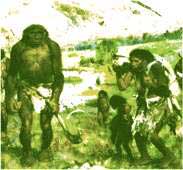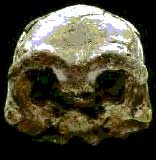 |
|
The Hominid Species |
On this beautiful, verdant Earth, it can be said that humans are the most remarkable primates among all living beings. With the advancement of human history and the development of science, we have completely decoded the human genome, controlled and cultivated various species of flora and fauna in nature, and even managed and evolved humanity itself. But where do humans come from? This complex, intricate, and ancient question remains unanswered by scientists to this day.
According to Darwin’s theory of evolution, humans gradually evolved from ancient apes, but several aspects of this evolutionary process are still not thoroughly explained. In recent years, some new discoveries in archaeology have compelled scientists to reconsider this issue, leading to several new hypotheses, some of which seem quite plausible.
 Paleontological studies suggest that the ancestors of humans – ancient apes – lived approximately 4 to 8 million years ago, while the direct ancestors of modern humans – the Southern ancient apes – existed around 4 million years ago. Fossil records from about 4 million years ago show no transition from ancient apes in deep forests to Southern apes. So, what transformations occurred during this period that caused ancient apes, accustomed to life in trees and moving on all fours, to evolve into bipedal beings and eventually into humans?
Paleontological studies suggest that the ancestors of humans – ancient apes – lived approximately 4 to 8 million years ago, while the direct ancestors of modern humans – the Southern ancient apes – existed around 4 million years ago. Fossil records from about 4 million years ago show no transition from ancient apes in deep forests to Southern apes. So, what transformations occurred during this period that caused ancient apes, accustomed to life in trees and moving on all fours, to evolve into bipedal beings and eventually into humans?
In 1960, British anthropologist Alisthe presented geological evidence showing that between 8 and 4 million years ago, in the homeland of ancient apes – Eastern Africa, there were traces of a vast area of land submerged by the sea, forcing some ancient apes to adapt to life in the water, becoming aquatic apes. Hundreds of thousands of years later, as the sea receded, these aquatic apes returned to land and became the ancestors of modern humans. As  such, the lack of fossil records during this period can be explained by the fact that human ancestors lived in the sea rather than on land. This concept, known as the “aquatic ape hypothesis,” stirred considerable debate in the scientific community. Alisthe also pointed out that this marine phase in the evolutionary history of humanity has left numerous traces on modern human bodies. Many physiological traits of humans resemble those of marine mammals like seals, contrasting sharply with those of terrestrial mammals. For example, all primates have a thick outer layer of fur, while humans have significantly reduced this layer, eventually losing it entirely. Additionally, the secretion of tears, which removes some salt, the regulation of body temperature through sweating, and other behaviors are characteristics of marine mammals. Particularly in the neonatal stage, if submerged in water, humans exhibit a “dive reflex” similar to seals, and their underwater breath-holding duration far exceeds that of terrestrial animals.
such, the lack of fossil records during this period can be explained by the fact that human ancestors lived in the sea rather than on land. This concept, known as the “aquatic ape hypothesis,” stirred considerable debate in the scientific community. Alisthe also pointed out that this marine phase in the evolutionary history of humanity has left numerous traces on modern human bodies. Many physiological traits of humans resemble those of marine mammals like seals, contrasting sharply with those of terrestrial mammals. For example, all primates have a thick outer layer of fur, while humans have significantly reduced this layer, eventually losing it entirely. Additionally, the secretion of tears, which removes some salt, the regulation of body temperature through sweating, and other behaviors are characteristics of marine mammals. Particularly in the neonatal stage, if submerged in water, humans exhibit a “dive reflex” similar to seals, and their underwater breath-holding duration far exceeds that of terrestrial animals.
 |
|
Comparison of Limbs in Apes and Humans |
The “aquatic ape hypothesis” provides explanations for many unique features of humanity, but numerous scientists express opposition, primarily due to the lack of sufficient fossil evidence to support this theory.
Another explanation points out that one of the greatest differences between humans and animals is that humans possess language capabilities. The full function of humans is inseparable from the intricate structure of the human vocal apparatus. However, anatomical studies show that the structure of the larynx in primates cannot evolve into that of humans; in other words, the human larynx did not evolve from primate ancestors but is a result of genetic inheritance from another species. So where does this “genetic inheritance from another species” come from? Reports suggest that this is the result of alien genetic manipulation conducted on ancient humans hundreds of thousands of years ago.
 |
|
Human Fossils in Ethiopia |
Some believe that not only the larynx but throughout the evolutionary process, remnants of “humans” are found everywhere. Thus, evolution is not merely a continuous development process but also occurs in a relatively stable process with sudden leaps of change. Otherwise, we would have no way to explain some of the fundamental characteristics of humanity, such as intelligence and language. These are miraculous occurrences that emerged within a very short time span of just tens of thousands of years.
In recent years, archaeologists have continuously discovered a series of human fossils in Ethiopia and Kenya in Central Africa. Notably, the discovery of the earliest human fossil – “Luxi,” has provided archaeologists and anthropologists with significant evidence in studying human evolutionary processes. With ongoing in-depth research, we have reason to believe that the mysterious door to the origins of humanity will eventually be opened.



















































